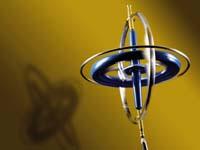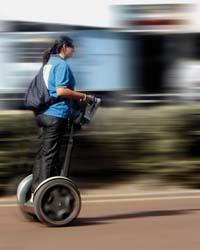Gyroscopes, balanced dance devices

It seems that riding a bike is a competition against gravity, being on two wheels, how does not the cyclist fall? The answer consists of handling the handlebars. Tilting the handlebars, the cyclist is able to create a centrifugal force that keeps the bike standing. But not only that, the wheels receive another additional effect by the simple spin.
It is a gyroscopic effect: the axis of a rotating body tends not to move. By pushing the turning axis, it opposes the impulse and the turning axis does not change position. In the case of the bike, gravity pulls the shaft of the wheels down, but the shaft is opposed.
The faster it rotates, the stronger the gyroscopic effect. And vice versa. The bike wheels, for example, do not turn very fast, at least as fast as the gyroscopic effect is opposed to gravity. The wheels of an engine are efficient gyroscope. When the driver tilts the engine takes the curve, but the two wheels that it has on the bottom do not let him fall.
Everything That Turns

The wheels are not the only example. All that turns is a gyroscope because it works under the gyroscopic effect. A planet, a comb, a ball or a gymnast on ice. If tour becomes a gyroscope.
The gyroscopic effect is easily visible on the disk called freesbie, which if you shoot turning flies without changing the orientation of the rotation axis. The flight of a bumeran has the same effect, but since it has no disk shape and when it is released, it produces a very asymmetric rotation, it does not fly in the same way. In short, the axis of a bumeran does not fully balance the external force and changes the orientation during the flight (that is why it returns to the launcher, among other things).
The movement that makes the axis of rotation of the Bumerana is called in physics: the precesion. It is like a dance, the gyroscope turns and at the same time turns the turning axis. In addition to bumerans, many gyroscopes perform this dance. For example, the axis of rotation of the Earth is the one that has the precesion and, to give a closer example, the motion of precesion is carried out by a children's toy, the nipple. In all examples, the axis cannot fully withstand the external force and the orientation of the axis changes in a circle. The precession seems like a movement that flees control, but takes advantage to take advantage of the most interesting applications of the gyroscope.
Precession under control

How to control the precesion? Simple, keeping the shaft. Just keep the shaft fixed or install the gyroscope in a cardan system. (It is called cardan to the bow that rotates in one direction). By fixing the axis of a gyroscope, it cannot follow the precesion. Since the axis tends not to change the orientation, what is maintained is also maintained.
It can be a whole boat, with a very large gyroscope. This idea was used as the heart of the anti-reservoir system of the ships --and patented -, XX. the first quarter of the twentieth century. The waves induce the boats to swing to one side and the other, but through a giant gyroscope attached to both sides of the hull, the gyroscopic effect can reduce this swinging. Subsequently, other systems were invented to stop the rolling, based on liquid or gas tanks, which exceeded the need for the giant gyroscope to turn. But a large gyroscope stabilizes the balance of a ship.
In a single rail train the effect is the same. However, by tilting the train in the curves, different gyroscope systems have been used to control the angle of inclination.
Rotary guides

The gigantic gyroscope brought new ideas to the vehicle industry, which were tested not only on boats and trains, but also on other vehicles. But the real success was achieved by small gyroscopes. Due to their small size they could not be used to stabilize the entire vehicle, but they were exceptional to guide navigation. At present, most navigation systems are based on gyroscope.
The automatic aircraft pilot is a good example. The main objective of an automatic pilot is to keep the plane horizontally and in balance by means of an artificial horizon line. And what better than a gyroscope to be the heart of the artificial horizon line?
When it rotates, the gyroscope does not change the axis orientation, even when it is inside a plane. Therefore, when the plane bends, the gyroscope does not follow him. If at first it was vertical with respect to the earth, when the plane is tilted it will also be vertical with respect to the earth. Seen from the pilot's place, the gyroscope will always move with the horizon line. The only thing the autopilot must do is to activate the navigation system so that the plane is aligned at all times with the gyroscope. That is, the gyroscope continuously informs the system of horizontality.

Top and bottom
It is very useful to know what is horizontal, what vertical, where "up" goes and where "down". A machine that knows it will not fall if not intentionally transmitting the information to the propulsion system.
A two-legged robot will not lose balance, nor a modern vehicle called a segway, in which a person is above (even if that means a change of weight! ). An artificial satellite, the ISS station and the Hubble telescope can be reoriented according to needs.
In general, any instrument that moves in three dimensions will benefit from a system of gyroscope. Gyroscopes are used with glasses to work with virtual reality. Also the controllers of the Wii games that have become fashionable, and the Mouse computer mice, a mouse that works without touching surface. All of them, and many other inventions, are provided with a gyroscope.
Traditional vehicles were the first to exploit rotary devices. Now, modern vehicles, robots, mice, etc. It is clear that the 'domestication' of the gyroscope has meant a semi-silent revolution in technology. Man has benefited greatly, perhaps because man lives in a great gyroscope.






